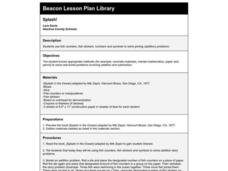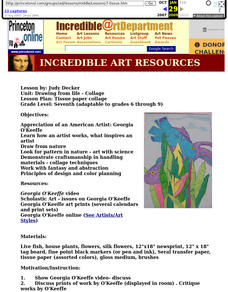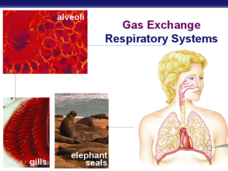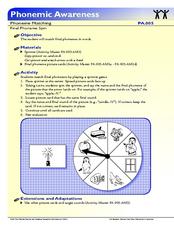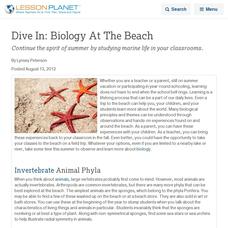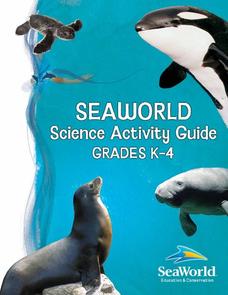Curated OER
Splash!
Students listen to the book, Splash in the Ocean. Then they use fish counters, fish stickers, numbers and symbols to solve addition story problems.
Curated OER
Critters of the Water
Students examine different organisms in various marine habitats. They identify any adaptations that have allowed the organisms to survive. They develop an imaginary organism and describe its life cycle.
Curated OER
Barnacles: Harder than Cement
Fourth graders watch the movements of the complex animal hidden inside the tiny barnacle shells. This instructional activity allows students to study the behavior, adaptation, and larval stage of the barnacle.
Curated OER
Drawing from Life: Tissue Paper Collage
Students watch a video about the artist Georgia O'Keeffe and discuss her work. They draw flowers plants and fish and use collage techniques imitating O'Keeffe's style.
Curated OER
Animal Playing Cards
Young scholars research animal characteristics including information about mammals, reptiles, birds, and fish. They place the information into a database and then, create playing cards using the information.
Curated OER
Stream Habitats and Biota
Young scholars identify native and introduced species of fish, shellfish and insects that inhabit Hawaii's streams. They use this information to predict the impact of stream restoration projects in Hawaii.
Curated OER
Arti'stick Mobile
Young scholars examine works of stained glass in one dimensional art form then adapt it a three dimensional transparent mobile. They create their mobile using patterns of shapes and simple images from computer line art, printed art books...
Curated OER
Venom!
Students examine the nature of venom. They conduct an experiment to demonstrate how proteins such as venoms can be denatured using raw eggs, beakers, heated water, and compresses.
Curated OER
Aquatic Organisms and Their Habitats
Middle schoolers investigate the presence of specific organisms in a freshwater habitat to determine the quality of that habitat. They conduct a field study and distinguish and classify organisms found during the field study.
Curated OER
Project Conclusion
In this cells activity students answer questions regarding the characteristics of living organisms observed during a pond water survey. Students draw diagrams of a food chain.
Curated OER
Northwest Coast Indians: Spring and Summer Salmon
Here is a fabulous lesson about the cultures of the Northwest Indians. Through an exploration of a story about the Salmon People, learners study the practice of harvesting salmon and the cultural importance of salmon to the Northwest...
Curated OER
Circulatory Systems
Excellent diagrams, labels and summaries make this resource be valuable to your students throughout the topic of circulation. All types of circulation vessels are explained, their structure and function is detailed, and the overall...
Curated OER
Circulatory Systems
A slideshow that covers the all-important details related to basic human circulation. The reasoning for exchange of material methods is presented and then labeled diagrams of the main human transfer systems are shown, along with...
Curated OER
Gas exchange: Respiratory Systems
The need for a respiratory system in humans versus being reliant on gas exchange structures is demonstrated. There are many details about the advantages and disadvantages of each mechanism. Students are able to learn about the...
Curated OER
Habitat Basics
First graders get out and explore two different habitats to examine how each one meets the needs of the plants and animals that dwell there. They discuss what they've learned about animal habitats as they explore the outdoor environment....
Discovery Education
Sonar & Echolocation
A well-designed, comprehensive, and attractive slide show supports direct instruction on how sonar and echolocation work. Contained within the slides are links to interactive websites and instructions for using apps on a mobile device to...
Florida Center for Reading Research
Final Phoneme Spin
Segmenting words into different phonemes helps kids on the road to reading and writing. Have some fun with this spinner game which includes all the print-outs you will need. Simply assemble the spinner using a brad and lay out the...
Curated OER
Salmon in the Classroom
Students list the salmon life cycle stages in order. They draw a stream with the vegetation, animals, and water quality parameters that are necessary for salmon survival. Students explain the connection between animal morphology and...
Curated OER
Dive In: Biology At The Beach
Continue the spirit of summer by studying marine life in your classrooms.
Exploratorium
Bird in the Cage
When your life science class is learning about the eye and how it works, you can add this activity as a demonstration of how the retina holds an afterimage. After staring at a red, green, or blue bird shape, pupils glance at a cage and...
Florida Center for Reading Research
Phonics: Encoding and Decoding, A Digraph A Word
Learners view a series of images, then choose digraphs, consonants, and vowels to spell out the object's name on each card.
Curated OER
Animals Must Fit In
A instructional activity on tadpoles is here for your young biologists. Learners read a short paragraph on tadpoles, then answer three questions regarding how parts of their bodies help the tadpole to survive in the pond. There is a good...
Curated OER
The Old Man and the Sea: The K-W-H-L Strategy
Make note of what readers know, what to know, and have learned during a unit on Ernest Hemingway's The Old Man and the Sea. As class members read the book, they jot down their ideas on a KWHL chart, and consider what they have...
Sea World
Seaworld Science Activity
A fun collection of activities about marine life would be a great addition to your elementary science unit. From cute penguins to scary sharks, the unit features crafts, experiments, and basic research projects that will teach your...
Other popular searches
- Clown Fish Adaptations
- Puffer Fish Adaptations
- Bony Fish Adaptations
- Potato Fish Adaptations
- Fashion a Fish Adaptations
- Adaptations of Fish
